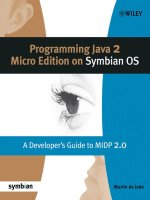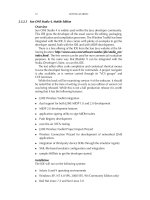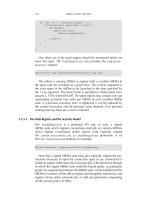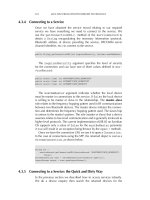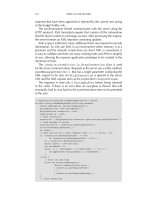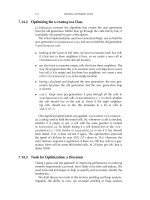Wiley java ME on symbian OS inside the smartphone model mar 2009 ISBN 0470743182 pdf
Bạn đang xem bản rút gọn của tài liệu. Xem và tải ngay bản đầy đủ của tài liệu tại đây (5.89 MB, 486 trang )
Java ME on Symbian OS
Roy Ben Hayun
With
Sam Mason, Daniel Rocha, and Ivan Litovski, assisted by Sam
Cartwright
Reviewed by
Gavin Arrowsmith, Brendan Donegan, Erik Jacobson,
Martin de Jode, Mark Shackman, Jo Stichbury
Head of Symbian Press
Freddie Gjertsen
Managing Editor
Satu McNabb
A John Wiley and Sons, Ltd., Publication
Java ME on Symbian OS
Inside the Smartphone Model
Java ME on Symbian OS
Roy Ben Hayun
With
Sam Mason, Daniel Rocha, and Ivan Litovski, assisted by Sam
Cartwright
Reviewed by
Gavin Arrowsmith, Brendan Donegan, Erik Jacobson,
Martin de Jode, Mark Shackman, Jo Stichbury
Head of Symbian Press
Freddie Gjertsen
Managing Editor
Satu McNabb
A John Wiley and Sons, Ltd., Publication
Copyright 2009
John Wiley & Sons Ltd, The Atrium, Southern Gate, Chichester,
West Sussex PO19 8SQ, England
Telephone (+44) 1243 779777
Email (for orders and customer service enquiries):
Visit our Home Page on www.wiley.com
All Rights Reserved. No part of this publication may be reproduced, stored in a retrieval system or transmitted in any form
or by any means, electronic, mechanical, photocopying, recording, scanning or otherwise, except under the terms of the
Copyright, Designs and Patents Act 1988 or under the terms of a licence issued by the Copyright Licensing Agency Ltd,
Saffron House, 6–10 Kirby Street, London EC1N 8TS, UK, without the permission in writing of the Publisher. Requests to
the Publisher should be addressed to the Permissions Department, John Wiley & Sons Ltd, The Atrium, Southern Gate,
Chichester, West Sussex PO19 8SQ, England, or emailed to , or faxed to (+44) 1243 770620.
Designations used by companies to distinguish their products are often claimed as trademarks. All brand names and
product names used in this book are trade names, service marks, trademarks or registered trademarks of their respective
owners. The Publisher is not associated with any product or vendor mentioned in this book.
This publication is designed to provide accurate and authoritative information in regard to the subject matter covered. It
is sold on the understanding that the Publisher is not engaged in rendering professional services. If professional advice or
other expert assistance is required, the services of a competent professional should be sought.
Other Wiley Editorial Offices
John Wiley & Sons Inc., 111 River Street, Hoboken, NJ 07030, USA
Jossey-Bass, 989 Market Street, San Francisco, CA 94103-1741, USA
Wiley-VCH Verlag GmbH, Boschstr. 12, D-69469 Weinheim, Germany
John Wiley & Sons Australia Ltd, 42 McDougall Street, Milton, Queensland 4064, Australia
John Wiley & Sons (Asia) Pte Ltd, 2 Clementi Loop #02-01, Jin Xing Distripark, Singapore 129809
John Wiley & Sons Canada Ltd, 6045 Freemont Blvd, Mississauga, Ontario, L5R 4J3, Canada
Wiley also publishes its books in a variety of electronic formats. Some content that appears
in print may not be available in electronic books.
Library of Congress Cataloging-in-Publication Data
Hayun, Roy Ben.
Java ME on Symbian OS : inside the smartphone model / Roy Ben Hayun, with Sam Mason ... [et al.].
p. cm.
Includes bibliographical references and index.
ISBN 978-0-470-74318-8 (pbk. : alk. paper) 1. Smartphones–Programming. 2. Java (Computer program language)
3. Symbian OS (Computer file) I. Title.
TK6570.M6H33 2009
005.26’8–dc22
2008053889
British Library Cataloguing in Publication Data
A catalogue record for this book is available from the British Library
ISBN 978-0-47074318-8
Typeset in 10/12 Optima by Laserwords Private Limited, Chennai, India
Printed and bound in Great Britain by Bell & Bain, Glasgow
This book is printed on acid-free paper responsibly manufactured from sustainable forestry
in which at least two trees are planted for each one used for paper production.
Contents
Foreword
ix
Kicking Butt with Java Technology on Symbian OS
xv
About This Book
xvii
Author Biographies
xix
Author’s Acknowledgements
xxi
Symbian Press Acknowledgements
Part One: Introduction to Java ME and
Programming Fundamentals
1
Introduction to Java ME, Symbian OS and
Smartphones
1.1
1.2
1.3
1.4
1.5
1.6
1.7
1.8
2003: Rise of the Mobile
2008: Mobile Generation
Meet the Host – Symbian OS
What Is Java?
Java ME
Why Use Java ME on Symbian OS?
Java’s Place in the Sun
Routes to Market
xxiii
1
3
3
6
7
9
12
17
21
22
vi
CONTENTS
1.9
1.10
1.11
2
Time for a Facelift
Back to the Future: MSA 2.0 and MIDP 3.0
Summary
Fundamentals of Java ME MIDP Programming
2.1
2.2
2.3
2.4
2.5
2.6
2.7
2.8
2.9
2.10
2.11
2.12
Introduction to MIDP
Using MIDlets
MIDP Graphical User Interfaces API
Non-GUI APIs in MIDP
MIDP Security Model
Networking and General Connection Framework
Using the Push Registry
MIDP and the JTWI
Mobile Media API
Wireless Messaging API
Symbian OS Java ME Certification
Summary
24
24
26
27
27
28
34
56
59
69
78
81
82
95
100
101
Part Two: Java ME on Symbian OS
103
3
105
Enter Java ME on Symbian OS
3.1
3.2
3.3
3.4
3.5
3.6
3.7
3.8
3.9
3.10
4
Running a MIDlet on a Symbian Smartphone
Which APIs Are Supported?
Proprietary JAD Attributes
Computing Capabilities of Java ME on Symbian OS
Java ME: Exposing the Power of Symbian OS
Tools for Java ME on Symbian OS
Java ME Management on Devices
Crossing to the Native Land of Symbian OS
Finding More Information
Summary
Handling Diversity
4.1
4.2
4.3
4.4
4.5
4.6
4.7
4.8
General Approaches to Handling Diversity
Detecting Diversity using Properties
Using Adaptive Code and Flexible Design to
Handle Diversity
Handling JSR Fragmentation
Handling Transitions Between Foreground and
Background
Supporting Diverse Input Mechanisms
Handling Diverse Multimedia Formats and
Protocols
Handling Screen and Display Diversity
106
113
122
123
125
131
131
139
145
146
149
150
151
153
158
161
162
166
169
CONTENTS
4.9
4.10
5
A Last Resort: NetBeans Preprocessing
Summary
Java ME SDKs for Symbian OS
5.1
5.2
5.3
5.4
5.5
Recommended Tooling Approach for Java ME on
Symbian OS
Generic SDKs: Java ME SDK 3.0 and WTK 2.5.2
SDKs for the S60 3rd Edition and 5th Edition
Platforms
SDKs for the UIQ 3 UI Platform
Summary
vii
173
173
175
176
177
178
189
205
Part Three: MSA, DoJa and MIDP Game
Development
207
6
209
Designing Advanced Applications with MSA
6.1
6.2
6.3
6.4
6.5
6.6
7
DoJa (Java for FOMA)
7.1
7.2
7.3
7.4
7.5
7.6
7.7
7.8
7.9
8
What Is MSA?
What Can I Do with MSA?
Spicing up Legacy MIDP Applications
Beyond MSA 1.1: MIDP 3.0 and MSA 2.0
MSA and Symbian OS
Summary
In the Beginning. . .
DoJa – the Basics
I Love JAM
DoJa Basic Operations Manual
Eclipsing DoJa
Dirty Hands
A Safe Port
DoJa 5.1 Profile
Summary
Writing MIDP Games
8.1
8.2
8.3
8.4
8.5
What Is a Game?
Building a Simple MIDP Game
MIDP 2.0 Game API Core Concepts
Building an Advanced Java Game on Symbian OS
Summary
209
213
222
227
229
230
231
231
234
238
240
240
243
250
254
264
265
266
273
279
282
303
viii
9
CONTENTS
Java ME Best Practices
9.1
9.2
9.3
9.4
9.5
Investing in the User Experience
Good Programming Practices
Streamlining the Deployment and Execution
Lifecycle
General Tips for Symbian OS
Summary
305
305
308
322
325
327
Part Four: Under the Hood of Java ME
329
10 Java ME Subsystem Architecture
331
10.1
10.2
10.3
10.4
10.5
10.6
10.7
10.8
10.9
10.10
Java Applications and Symbian OS
Application Management Software
MIDP Push
Mean and Lean Virtual Machine
MIDP Implementation Layer
Handling Asynchronous Symbian OS Operations
Java-level Debugging Support
Performance
Security
Summary
11 Integration of Java ME and Native APIs
11.1
11.2
11.3
11.4
11.5
11.6
Importance of Integration with Symbian OS
Services
Types and Levels of Integration
Integration Challenges, Costs and Considerations
Determining the Right Integration Style
Examples of JSR Integration
Summary
331
336
337
338
342
346
348
349
350
351
353
354
356
357
358
359
384
Appendix A: WidSets
385
Appendix B: SNAP Mobile
411
References
433
Index
435
Foreword
James Coplien
It was great re-discovering through this book just how much of a nerd I
am. Roy’s descriptions and exercises painted amazing pictures in my head
of the internal workings of my own Nokia S60 phone, to the extent that I
unearthed new and useful menus previously invisible to me. While I can’t
promise that every casual reader will find this book suitable as a user’s
guide, and while I can’t promise that every programmer will become an
expert user of their own handset by reading the chapters that follow, I can
promise the intent programmer a treasure chest of knowledge not only
for understanding what goes on inside your phone but also for changing
what goes on inside your phone.
Java ME on Symbian OS is a title that sounds like nerd’s heaven – and
it is (though it’s more than that, as I’ll come back to below). Though
the title bears two trade names, the meat of the book proudly displays
its inclusiveness across the market: Sun, Symbian, Nokia, Samsung, LG,
Sony-Ericsson, Motorola . . . It’s the ultimate mash-up. This is a book less
about niche technologies than about a broad phenomenon. It isn’t only
a technological phenomenon but a sociological one; if you don’t view it
that way today, I believe that vision is rapidly approaching tomorrow.
To the everyday programmer, I think this book will open a new
world of wonder, as history has similarly favored our industry several
times in the past. Twenty years ago, someone would have thought
you to be drunk if you asked him to take a picture of you with his
phone. Today we have lost touch with photographic film and, to a large
degree, with those ancillary devices called cameras. We used to have a
shelf-full of gadgets for voice dictation on the run, digital photography,
calendar management, and, yes, even communication – all of which are
x
FOREWORD
converging on single small, convenient computers that are the braingrand-grand-grand-grand-children of Alexander Graham Bell. And those
boxes need software – software such as you will find in this book, along
with guidance for bringing it to life.
It was inevitable that the evolution of consumer programming should
turn to the telephone. I remember the visions of unification of computers
and telephones in the minds of people such as Jerry Johnson back in
Bell Lab in the 1970s. We can now look back at the past 20 years and
conclude that computers’ primary contribution to society has been not
as calculating engines in their own right, but as tiny points on an almost
fully-connected network that ties together most computers in the world.
The phone network is more than just a metaphor for the worldwide web:
it is often its backbone. As the pundits predicted, the intelligence has
evolved out of the network into its periphery, out of its bowels and into
its eyes, ears, and fingers.
The intelligence hasn’t stopped at phones. Next year, Nokia and RWE
are expected to market a box that extends the phone network to control
heating, window shades, and home security cameras. The possibilities are
endless. Programmable phones will replace not only cameras and small
dictation machines, but will reach ever further into both our immediate
and physically remote realities. They have already made a significant
foray into the video game space, taking advantage of advancing display
technology, complementing our newfound connections with reality with
newfound escapes into fantasy. In the not so distant future, these two
worlds may blend and merge. Whereas yesterday’s play was a personal
Tamagotchi and today’s play includes multiple Tamagotchis talking via
an infrared Tamacom protocol, tomorrow will see our phones as a
Tamagotchi interface whereby we feed or clean up after the flesh-andblood Fido back home – all with a sequence of a few DTMF tones.
Roy’s book takes us on a journey into a land that is more than
just nerd heaven. The history of computing has drawn more and more
everyday folk into programming. This trend sits squarely in the center
of the vision of people such as Alan Kay and Adele Goldberg: that
computers should be the sidekicks of human beings from early life,
enabling children of all ages to extend their memory and processing
power by manufactured, rather than biological, means. This vision of a
Dynabook – a truly personal computer, an extension of self – includes
information tethered to the outside world as one of its central building
blocks. Because my Dynabook is part of me, I get to program it. Today,
that programming means setting a date on my calendar or setting an
alarm for a meeting. Those humble acts may not entail using Java, but
FOREWORD
xi
it’s still programming: as Dan Barstow used to say, ”No matter how
high-level, it’s still programming.” To me, as a C++ programmer, Java
looks almost like a scripting language. And that’s not even an insult.
Java has perhaps finally realized its vision of ubiquitous expression of
general-purpose computation that is portable and intelligible enough that
Everyperson can at least tweak the code. I know that such æsthetics
are difficult to judge from the seat of a professional programmer, but
we can at least say that Java code provides a glimpse of such a world.
Perhaps even my neighbor, the real-estate salesman, could read some of
the code in this book and understand it well enough to play with it. Or
my dentist. Or my banker. None of them are professional programmers.
But each has a computer on his or her desk: a machine which 40 years
ago would have terrified most secretaries, and which still terrifies some
executives today. Machine creatures inhabit more and more of the human
ecosystem.
It’s interesting to note that such programmability has played out not in
desktop phones (yes, they still exist) but in hand-held portable phones.
Why? Perhaps it is because only personal cellular phones are close
enough to our heart – or some other part of our anatomy – to truly be part
of Self. It was a revolution when people who bought the early Ataris and
Amigas discovered that they could actually program them themselves. We
are perhaps on the threshold of a revolution that unleashes more powerful
programming into the hands of what will be over one billion owners of
Symbian OS phones in two or three years. Even if great programmers arise
from only one in a million of these users of small-handheld computers
that take pictures, play games, and even place phone calls, it will be
enough to move the world.
This book, as a nerd’s text, is nonetheless a bold foray into Dynabook
territory. If nothing else, it will make you realize that if you own a
regular personal computer and a mobile phone, that it’s within your
reach – today – to write software that can be an at-hand extension of
yourself any time, anywhere. It is perhaps one small step on the road to a
future vision of even further integration between man and machine. Such
integration must go forward with intense ethical scrutiny and social care;
if we choose such a path, machines can make us even more human,
humane, and social than we are today.
I leave you with a poem which, when published, was wrongly
attributed to me alone. It was written by the attendees at VikingPLoP
2004 as we took the human–computer symbiosis to its limit. Think of
Java ME on Symbian OS as an important step on this journey. Nerds,
children of all ages, and everybody out there: Happy Programming!
xii
FOREWORD
Comfortable as blue jeans
She fits.
Part of me, yet not me;
Unplugged: oxygen is her food
And the breeze her power adaptor.
Her identity mine, yet not me:
I put her down, I take her up
like a well-worn wallet plump
with life’s means and memories.
A thin mask worn in life’s play
And both of us are players.
I call her Self; she does not call me User
A curse unique to programmers and other pushers.
I and my computer are one
But we own each other not.
Envision this: my new machine, a soulmate,
With whom I talk in whispers unencumbered by flesh and bone
Software begotten, not made
Of one being with its person.
She hears my voice, and perhaps my thoughts
rather than the drumming of my fingers
that burdened her forebears:
35 calcium levers linking brain to digits,
slow and tired machines of the information age.
Now, mind to mind,
there for tea and sympathy
all day, and our night
minds together process the day,
sharing dreams – yet
She slumbers not, nor sleeps.
An invisible mask the birthright of all humanity;
Her software penned by
My soul
And like my soul, her hardware
Im-mortal, invisible
Us together wise.
Transparent personæ mine, yet not me,
That with me loves, and lives, and walks life’s journey –
A path both real and virtual at once
as only a True and rich life is.
FOREWORD
xiii
With me she dies
– our immortality inscribed in
the fabric of the network.
No duality of community here
and Internet there –
The Network is the Community:
One Web of life.
Jim Coplien
Mørdrup, Denmark
2 July 2008
en.wikipedia.org/wiki/James O. Coplien
Kicking Butt with Java Technology on
Symbian OS
Mobile phones have changed the lives of billions of people and it’s
clear that the revolution is just beginning. The quickly evolving world
of mobile technologies is an exciting place for developers to create new
applications to connect people and information.
Java technology has enjoyed dizzying success in just under a decade
in the mobile phone industry. As I write, more than 2.1 billion Java
technology devices are deployed worldwide. At the same time, Symbian
OS dominates the fast-growing smartphone market (with approximately
70%). This book is about the confluence of these two technologies and
how to create your own powerful mobile applications.
Now is a great time to be a mobile developer. You can help shape
the coming landscape of advanced mobile applications by harnessing the
power of both Java technology and Symbian OS. Learn the technologies,
let your imagination run free, and have fun!
Jonathan Knudsen
jonathanknudsen.com
Author of Kicking Butt with MIDP and MSA
About This Book
In 2001, Symbian published its first book devoted to Java on Symbian
OS. Jonathan Allin’s Wireless Java for Symbian Devices provided an
in-depth exposition targeted at programming PersonalJava on Symbian
OS. In 2004, Martin de Jode’s Programming Java 2 Micro Edition on
Symbian OS focused on programming MIDP, particularly MIDP 2.0 on
Symbian OS. This book is the third in the series and there is no longer a
need to explain what Java is. Therefore, the primary goal of this book is
not to teach Java programming but to introduce you specifically to Java
Platform, Micro Edition (Java ME) on Symbian OS.
This book covers various topics from different perspectives. Our
approach has been to start with the basics and prerequisites that are
assumed in the rest of the book, then zoom into Java ME on Symbian
OS specifically and then out again to discuss a few key areas of Java ME
development today. We finish the book by delving deep down to expose
what’s happening ’under the hood’.
The book logically divides into four main parts:
1. Introduction to Java ME and programming fundamentals
In Chapter 1, we describe the playground of Java ME on Symbian
OS. It is recommended reading if you are not familiar with Java
ME, Symbian OS or the smartphone industry. Chapter 2 is targeted
at developers with no experience in Java ME. It sets the baseline
information that is a prerequisite for reading the rest of the book,
which assumes a certain level of knowledge of Java programming
and, specifically, Java ME. Chapter 2 deals with the basic concepts
of a MIDlet, LCDUI, MMAPI, and so on.
xviii
2.
ABOUT THIS BOOK
Java ME on Symbian OS
Part 2 assumes you are familiar with Java ME but are interested
in learning about the Java ME platform hosted on Symbian OS.
Chapter 3 explains what makes Java ME on Symbian OS different
from other Java ME platforms; what makes it more powerful; and
what else is unique to Symbian smartphones. Chapter 4 provides
guidelines on how to handle differences between different Symbian
smartphones. Chapter 5 provides an overview of development SDKs
for Java ME on Symbian OS.
3.
Drill down into MSA, DoJa and MIDP game development
Part 3 expands the discussion into various key areas of Java ME
development. We show how to leverage the power of MSA, give
an introduction to how Java evolved very differently in the Japanese
market, provide a glimpse of games development and equip you with
best practices for your next application.
4.
Under the hood of Java ME
In Part 4, we reveal information that has rarely been exposed before.
Chapter 10 explains the internal architecture of the Java ME subsystem as a Symbian OS component and Chapter 11 explains how Java
ME on Symbian OS is tightly integrated with the native services.
Appendix A introduces WidSets which is a run-time environment that
makes use of the Java language and the Java ME platform. Appendix B
introduces SNAP Mobile for game developers.
This book contains a number of web addresses. If any of them are broken, please consult the wiki page for this book at developer.symbian.com/
javameonsymbianos to find the updated location.
We welcome beginners and professionals, third-party application
developers and OEM developers working inside Symbian OS. Whether
you’re just starting out in the exciting world of mobile development, want
to learn Java ME or just like reading interesting stuff, this book is a mix of
different topics that combine in the same way as a dish full of spices.
Author Biographies
Roy Ben Hayun
Roy Ben Hayun has more than 10 years’ experience in various Java
technologies in various software engineering roles: engineer, consultant,
team lead, tech lead, and architect. He started his career in Lotus IBM,
working on JDK 1.1.8, and then became a founding member of eMikolo
networks, which pioneered P2P in the early days of Project JXTA. He later
worked in various roles in other startup companies in Java SE, Java ME and
Java EE. From 2002 until the end of 2007, he worked for Symbian, mostly
in the Java group working on the design and implementation of JSRs and
CLDC-HI VM tools support. In his last year at Symbian, he worked in the
team supporting developers, during which time he authored a number of
technical articles and white papers about run-time environments.
After JavaOne 2007, Roy joined Sun Microsystems. He is currently
working as a system architect in the Engineering Services group, which
leads the development, marketing and productizing of Java ME CLDC
and CDC on various platforms.
Ivan Litovski
Ivan joined Symbian in 2002, working first in the Java Team and later with
the System Libraries, Persistent Data Services and Product Creation Tools
teams. Ivan has 11 years of professional experience with Java, embedded
software, information security, networking, scalable servers and Internet
protocols. He enjoys solving difficult problems and research and development. He has authored several patents and papers in peer-reviewed,
xx
AUTHOR BIOGRAPHIES
international journals. He holds a BSc in Electronics and Telecommunications from the University of Nis, Serbia and is an Accredited Symbian
Developer.
Sam Mason
Sam spent about two years working on a Java-based, multi-lingual,
video-on-demand system for SingTel and other Asia-Pacific Economic
Cooperation (APEC) telecommunications agencies. He has spent most of
the last four years working with and learning about mobile phone technologies, while picking up a couple of Java certificates and completing a
Master of Information Technology (Autonomous Systems) at the University of New South Wales along the way. He was a contributing author
to Games on Symbian OS, writing the chapters on Java ME development
and DoJa. He is an Accredited Symbian Developer.
Daniel Rocha
Daniel is a software engineer with 10 years’ experience in application
development, having worked with web (Perl, ASP, PHP, JavaScript, JSP,
Flash), enterprise (Java EE) and mobile software (Symbian C++, Java ME,
Flash Lite, Python). He currently works as a Forum Nokia Technology
Expert.
Author’s Acknowledgements
I feel vividly that this project was an amazing experience, primarily
because of the people involved. I am blessed that there are so many
people to thank – editors, contributing authors, reviewers, test readers
and colleagues.
Two of the people whom I had the honor to be guided by, Jo Stichbury
and Jim Coplien, I met for the first time on the same day. The place was
the ACCU conference in 2006 and the idea of writing the next book about
Java ME for Symbian OS was too embryonic to be called ’an idea‘. Jo
Stichbury (who had just returned from Nokia to Symbian) knew from her
own authoring experience how to deliver a book from start to finish, and
I am thankful for her personal guidance, her professionalism and wisdom
as a technical editor, which has always managed to find the right solution
at any time and on any matter.
I am also thankful for meeting Jim Coplien, a truly visionary guy. Full
of passion, equipped with his one-of-a-kind way of thinking, he has that
rare long memory into the past of software engineering and a vision into
the future of what will come out of all that we are currently doing.
I am also in debt to the wonderful people who have contributed from
their knowledge and experience: Ivan Litovski, Sam Mason and Daniel
Rocha. Ivan has been a great friend from day one in the Java group at
Symbian, and is a reviewer and contributing author to this book. Sam
is a passionate mobile expert and the founder of Mobile Intelligence in
Australia. I have been lucky enough to work with Sam on this book and to
meet and become friends at JavaOne 2008. Daniel has constantly given
this project wonderful support and his contributions, from his viewpoint
inside Forum Nokia, have been invaluable. He came to the rescue on
many occasions, and I’m truly appreciative of his hard work and energy.
xxii
AUTHOR’S ACKNOWLEDGEMENTS
I’d also like to thank Mark Shackman for the pleasure of working
with him during my four and a half years in Symbian. I am grateful for
his constant insistence on the build up of logical arguments and perfect
phrasing. Mark always delivers, and he manages to get the best out of
hundreds (by now probably thousands!) of embryonic articles and book
chapters.
Thanks also to Martin de Jode for his valuable comments from his own
experience in writing the second book in this series and much gratitude
to Satu McNabb for her support and for always being there to help.
I’d also like to acknowledge:
•
the people at John Wiley & Sons for working with us on this book
with their high standards of professionalism and quality
•
my current group, Engineering Services in CSG, Sun Microsystems,
which had the ability to see the future of Java from the remote distance
of the 1990s and leads the way towards the next generation of Java
technologies
•
the Java group in Symbian, of which I had the pleasure to be a member
during most of my time in London
•
the Developers’ Consulting team and the Developer Product Marketing team in Symbian
•
the many people who took time and patience to read all the suggestions and ideas that were yet to become chapters: Arnon Klein, Assaf
Yavnai, Yevgeny (Eugene) Jorov, Jonathan Knudsen, Tomas Brandalik,
Erik Hellman, Per Revesjo,
¨ Magnus Helgstrand, Lars Lundqvist, David
Mery, and Emil Andreas Siemes
•
my parents and sister and all of my friends.
Finally, this book is for my friend, partner and wife – Gabi – and our
wonderful, beloved children, Noa and Ariel.
For being blessed with everything that has happened and the things
that are yet to happen.
I hope you will enjoy reading this book.
